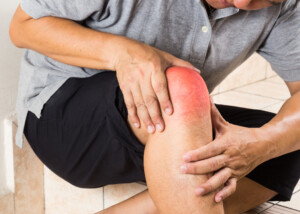
Chondromalacia patella and bursitis are common conditions that involve the kneecap, causing distinct pain.
But does one have any unique characteristic that the other one doesn’t?
“Bursitis usually involves inflammation of the prepatellar bursa,” says Reggie Alexander, MD, an orthopedic surgeon with Orthopaedic Specialists in Los Angeles, CA.
“It can be exacerbated by kneeling. It may be associated with local tenderness. Patellofemoral syndrome involves anterior [front] knee pain that can be exacerbated by kneeling, stairs or squatting.
“There may be crepitus (popping or crackling) in the patellofemoral joint when the knee is taken through range of motion.”
This range of motion can include simply extending and flexing the knee (straightening and bending) from a standing or seated position.
Any way for the layman to know what their knee condition is more likely to be?
“The presence or absence of swelling is helpful for determining this,” says Dr. Alexander.
“If swelling is present, it’s more likely to be knee bursitis as opposed to patellofemoral syndrome.
“Also, people should keep track of what activities exacerbate their symptoms. If kneeling is the only activity that exacerbates your symptoms, it’s more likely to be knee bursitis.”
If there’s no pain or discomfort when going up stairs, this does not rule out patellofemoral syndrome (which many laypeople also refer to as chondromalacia).
However, the feature symptom of this condition is that of increasing pain as one deepens into a squat or crouching position.
Any home tests they can give themselves to provide a clue to which condition they have?
Dr. Alexander says, “Note whether or not pain occurs with range of motion or if it’s isolated to one spot.
“If it’s isolated to one spot, then it is more likely to be knee bursitis.
“Also, if you’re experiencing swelling, it’s more likely to be knee bursitis.”
 Dr. Alexander’s sports experience covers many teams including those at the University of Chicago and at UCLA. Surgical and pain areas of expertise include the rotator cuff, ACL reconstruction, neck, back, hip and foot.
Dr. Alexander’s sports experience covers many teams including those at the University of Chicago and at UCLA. Surgical and pain areas of expertise include the rotator cuff, ACL reconstruction, neck, back, hip and foot.
 Lorra Garrick has been covering medical, fitness and cybersecurity topics for many years, having written thousands of articles for print magazines and websites, including as a ghostwriter. She’s also a former ACE-certified personal trainer.
Lorra Garrick has been covering medical, fitness and cybersecurity topics for many years, having written thousands of articles for print magazines and websites, including as a ghostwriter. She’s also a former ACE-certified personal trainer.
.









































